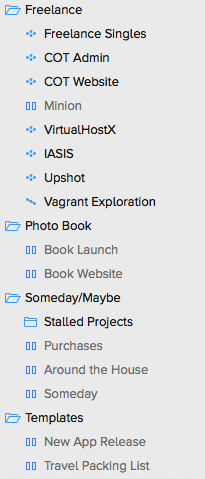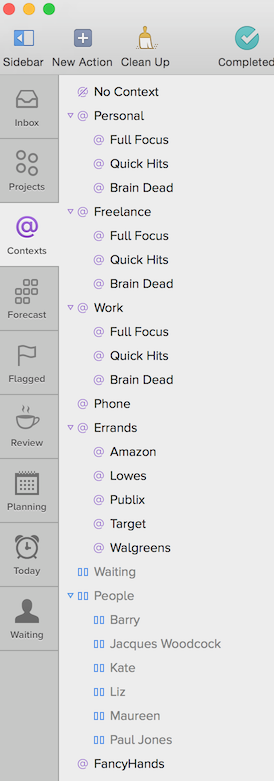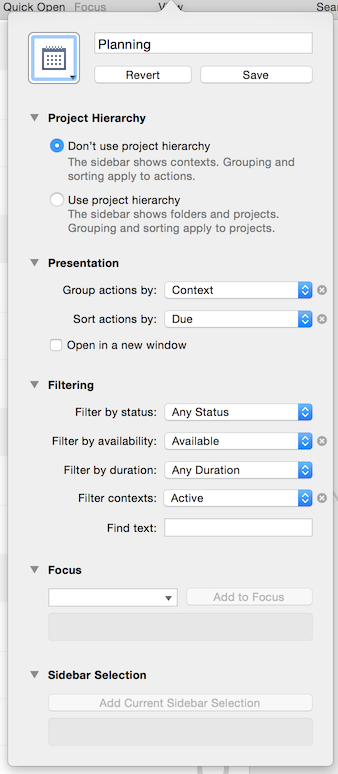I’ve been using OmniFocus since the Kinkless days. Over those many years, my life has changed in countless ways, and with it, so has the way I use OmniFocus. Perhaps the best compliment I can give the app, is that it’s always managed to be exactly what I needed it to be at any given moment.
Four years ago, I wrote a long post about how I used OmniFocus to manage the three areas of responsibility in my life: personal, work, and freelance. Those areas have all grown rapidly since then. I’ve had my first child, taken on a more demanding full-time job, and watched my side business grow into it’s own full-time operation.
I figure it’s time to show how my workflow with OmniFocus has evolved to take on the added responsibility in my life.
I’m going to break this post down into three sections:
- How I Organize My Projects
- How I Define and Implement My Contexts
- My Daily Workflow
Let’s get started.
How I Organize My Projects
Similar to what I described four years ago, the majority of my projects are sorted into three folders which represent the three primary areas of responsibility in my life:
- Personal
- Tandum (my day job)
- Freelance (my side business)
Other than the different job, that’s pretty much how things were four years ago. What’s different, however, are the three additional folders I’ve added to the bottom.
The first one, “Photo Book”, is for the book I’m writing. It’s a large enough task that I needed to break it down into multiple projects. I could have kept them under my “Freelance” folder since they technically are a side-project, but that felt wrong as writing is such a different beast than software development. And that’s one of the key lessons I’ve learned as my use of OmniFocus has evolved. Don’t feel like everything has to fit into a neat, pre-existing category. Don’t artificially restrict yourself. Feel free to let things land wherever makes sense to you.
The second and third additional folders are special. First, you’ll see that I’ve moved all of my Someday/Maybe/Tickler projects into one folder. I was tired of them littering my other project views, even being on-hold. Grouping them into one location helps my sanity. I also know they won’t be forgotten as they show up automatically at set intervals during my OmniFocus review.
The final folder is for template projects. These are projects that have many steps and frequently repeat. Instead of recreating the project from scratch each time, I create it one time and place it on hold. Then, whenever that project occurs, I can drag a copy of it into one of my active folders. The two template examples in this screenshot:
- New App Release: Every time I release a new version of one of my apps, there’s a concrete fourteen step process to ensure everything goes smoothly. I’ve eliminated most of the chance of error by using this project as a simple checklist for each step.
- Travel Packing List: This is a great idea I read somewhere else online. I used to worry every time I walked out the door to catch a flight that I had forgotten something. Now, I have a standard list of everything I need to pack that I can confidently go through before each trip. As you’ll see in the next section, each of the items on my travel packing list are assigned to a context of the store where I’ll need to buy them if they’re disposable. (Target, Walgreens, etc).
One rule of thumb I’ve learned the hard way is to never nest folders. Folders within folders just lead to a world of hurt and cognitive load. I’ve found it’s best to keep as flat a hierarchy as possible. Your milage may vary of course.
How I Define and Implement My Contexts
One of the most significant changes I’ve made is how I approach my contexts.
I used to go with standard run-of-the-mill contexts that related to the specific tools I needed at hand to complete a task. Things like “Mac”, “Phone”, “Home”, and “Work”. But after re-reading Getting Things Done last year, I came to the realization that most of my tasks are bounded not by what tools I have available, but by my energy level. Tasks such as “Write new blog post” and “Update credit card mailing address” are both something I need to do while at my computer but require vastly different levels of energy and time to complete. This insight led me to categorize my tasks into the following contexts:
- Full Focus – tasks which I need uninterrupted time and concentration to complete
- Quick Hits – tasks which I can knock out in just a few minutes, one after the other
- Brain Dead – tasks which require no energy or concentration
I found great success with splitting up all of my tasks into one of those three contexts. It allowed me to judge what sort of mood I was in and how much time was available before determining what to work on. After a few months of using this strategy, I further segregated things by breaking them out into parent contexts of “Personal”, “Work”, and “Freelance”, which correspond to my primary areas of responsibility. While not strictly necessary, this additional grouping allows me to focus on what’s appropriate depending on whether or not I’m at home or at work.
Of course, not all of my contexts relate to energy levels. I still have a “Phone” context and ones for stores I frequent. (Although, I no longer use OmniFocus for shopping lists other than for big-ticket, future/someday purchases. All of my family’s shopping lists are kept in sync between my wife’s and my iPhones using the wonderful Silo app).
You’ll also notice I have on-hold contexts for tasks that other people owe me. I wrote in detail about how I manage the relationships between tasks and other people a few weeks ago.
My Daily Workflow
The biggest and best improvement I made to my daily workflow was to codify my morning routine for picking what I’m going to work on that day. (In fact, a big part of determining what to work on each day was simply realizing I need to a concrete series of repeatable steps for choosing my day’s tasks.) Back in 2010, I wrote
It’s hard to describe how incredibly powerful Perspectives are until you actually spend a few days with them in your workflow. Other task managers have smart folders or dedicated “Today” lists, but they absolutely pale in comparison to the flexibility that Perspectives afford.
The same is still very much true today. I’ve taken OmniFocus’ perspectives feature and simplified them down to three custom perspectives I use to plan and attack my tasks for the day.
Each morning when I arrive at work, I switch to my “Planning” perspective. This perspective shows me every single task that I could possibly do, grouped by context. I take five minutes and work my way through each task and decide if it’s something I want to focus on today. If it is, I flag it. I try and pick two “Full Focus” tasks that I believe I can accomplish that day. This ties in nicely with my daily goal of doing one (or two!) concrete actions. Additionally, I pay special attention to any tasks in my “Quick Hits” or “Brain Dead” contexts. I try and flag as many of those as is reasonable, since I know there will be times during the day where my time will be limited or where I’ll be low on energy.
Once I’ve flagged what I want to do today, I switch over to my “Today” perspective. This perspective shows all of my flagged tasks in addition to anything that is due or due soon. The list is then sorted by due date. This gives me a complete overview of everything that must be done today (and anything with a due date should really be due that day, otherwise why have a due date at all?) and what I had previously flagged to complete today.
Throughout the rest of the day, I spend nearly all of my time in this “Today” perspective. I simply work my way through my list, item by item, working to get as much done as possible before it’s time to go home.
My final custom perspective is “Waiting”. That’s simply a list in context mode, focused on my on-hold tasks that other people owe me, grouped by person. This is particularly helpful when synced to my iPhone. When I’m in a meeting or run into someone, I can just tap this perspective and see if there’s anything we need to discus. For more details on how I handle the relationship between tasks and people, here’s a post I wrote earlier this year on the topic.
Wrapping Up
So, that’s it. That’s a quick summary of what my OmniFocus setup looks like four years since I last wrote in detail about the app. The biggest difference maker in my daily sanity has been the realization that I can stay on top of everything in my life with very little mental overhead if I simply trust my system and take five minutes every morning to plan my day. That, coupled with weekly reviews, ensures nothing falls through the cracks.
I’d love to hear about your own custom OmniFocus workflows. Feel free to email, tweet, or write to me in the comments below.




